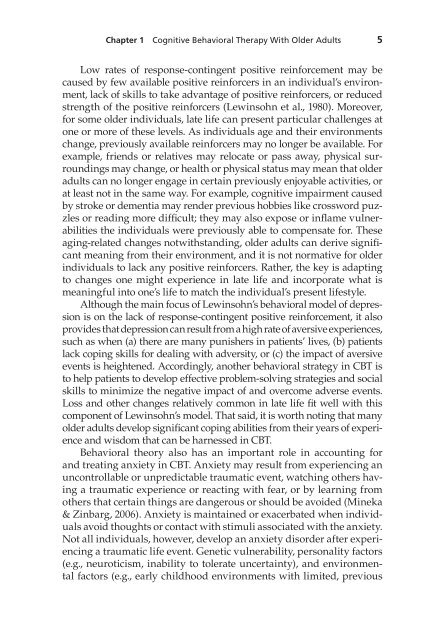Cognitive Behavior Therapy with Older Adults - Springer Publishing
Cognitive Behavior Therapy with Older Adults - Springer Publishing
Cognitive Behavior Therapy with Older Adults - Springer Publishing
Create successful ePaper yourself
Turn your PDF publications into a flip-book with our unique Google optimized e-Paper software.
Chapter 1 <strong>Cognitive</strong> <strong>Behavior</strong>al <strong>Therapy</strong> With <strong>Older</strong> <strong>Adults</strong> 5<br />
Low rates of response-contingent positive reinforcement may be<br />
caused by few available positive reinforcers in an individual’s environment,<br />
lack of skills to take advantage of positive reinforcers, or reduced<br />
strength of the positive reinforcers (Lewinsohn et al., 1980). Moreover,<br />
for some older individuals, late life can present particular challenges at<br />
one or more of these levels. As individuals age and their environments<br />
change, previously available reinforcers may no longer be available. For<br />
example, friends or relatives may relocate or pass away, physical surroundings<br />
may change, or health or physical status may mean that older<br />
adults can no longer engage in certain previously enjoyable activities, or<br />
at least not in the same way. For example, cognitive impairment caused<br />
by stroke or dementia may render previous hobbies like crossword puzzles<br />
or reading more difficult; they may also expose or inflame vulnerabilities<br />
the individuals were previously able to compensate for. These<br />
aging-related changes not<strong>with</strong>standing, older adults can derive significant<br />
meaning from their environment, and it is not normative for older<br />
individuals to lack any positive reinforcers. Rather, the key is adapting<br />
to changes one might experience in late life and incorporate what is<br />
meaningful into one’s life to match the individual’s present lifestyle.<br />
Although the main focus of Lewinsohn’s behavioral model of depression<br />
is on the lack of response-contingent positive reinforcement, it also<br />
provides that depression can result from a high rate of aversive experiences,<br />
such as when (a) there are many punishers in patients’ lives, (b) patients<br />
lack coping skills for dealing <strong>with</strong> adversity, or (c) the impact of aversive<br />
events is heightened. Accordingly, another behavioral strategy in CBT is<br />
to help patients to develop effective problem-solving strategies and social<br />
skills to minimize the negative impact of and overcome adverse events.<br />
Loss and other changes relatively common in late life fit well <strong>with</strong> this<br />
component of Lewinsohn’s model. That said, it is worth noting that many<br />
older adults develop significant coping abilities from their years of experience<br />
and wisdom that can be harnessed in CBT.<br />
<strong>Behavior</strong>al theory also has an important role in accounting for<br />
and treating anxiety in CBT. Anxiety may result from experiencing an<br />
uncontrollable or unpredictable traumatic event, watching others having<br />
a traumatic experience or reacting <strong>with</strong> fear, or by learning from<br />
others that certain things are dangerous or should be avoided (Mineka<br />
& Zinbarg, 2006). Anxiety is maintained or exacerbated when individuals<br />
avoid thoughts or contact <strong>with</strong> stimuli associated <strong>with</strong> the anxiety.<br />
Not all individuals, however, develop an anxiety disorder after experiencing<br />
a traumatic life event. Genetic vulnerability, personality factors<br />
(e.g., neuroticism, inability to tolerate uncertainty), and environmental<br />
factors (e.g., early childhood environments <strong>with</strong> limited, previous

















